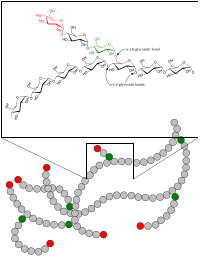
Photo from wikipedia
Long-chain–branched polypropylene (LCBPP) is one of polypropylenes (PPs) with high melt strength and good melt elasticity. Recently, due to its outstanding properties, LCBPP have been attracted increasingly attention in the… Click to show full abstract
Long-chain–branched polypropylene (LCBPP) is one of polypropylenes (PPs) with high melt strength and good melt elasticity. Recently, due to its outstanding properties, LCBPP have been attracted increasingly attention in the field of development and characterization by the researchers all over the world. In this study, LCBPP was prepared by the melt radical branching reaction in a torque rheometer. The influences of various acrylate monomers with different functionality degrees on the structure and melt performance of PP products were investigated. The results indicated that grafting monomers with different functionality degrees made diverse influences on the branching density and branching chain length of branching PP products. With the increase of the functionality degree of grafting monomers, the branching level of PP products increased gradually and the “multiplicity” of branches became increasingly obvious. Besides, a higher reactivity of pentaerythritol triacrylate with hydroxyl than the similar molecular structured pentaerythritol tetraacrylate was confirmed. Furthermore, due to the high reactivity of dipentaerythritol penta(hexa)acrylate, branching and crosslinking reaction occurred simultaneously during the reaction process. As a result, the gel content increased and finally formed highly star branching structures with a shape of “dense and short.”
Journal Title: Polymers for Advanced Technologies
Year Published: 2018
Link to full text (if available)
Share on Social Media: Sign Up to like & get
recommendations!